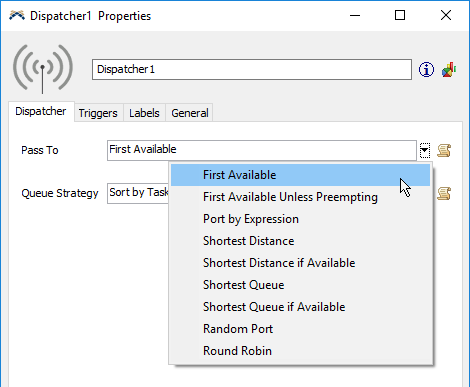question
locked postLockedcan anyone give me new "task executor dispatching strategy" along with its CODE?
I'm sorry I'm not exactly sure what it is you are looking for. Are you looking for a specific dispatching strategy? Could you please clarify your question a bit more.
New dispatching strategy other than default ones(shortest queue,shoretest distance,random port......) and a code for it
i.e, customised dispatching strategy and code for it.....
Please describe your desired dispatching strategy. How would it work? If we knew what you were looking for, we might be able to make a sample for you.
Apart from built in dispatching strategies we can make a strategy of our own by changing the code.I dont understand the logic of that coding.So please help me with that by assuming a new strategy of your own which is applicable in automated warehouse for dispatching robots Ex.shortest processing time, shortest remaining processing time... @Sam Stubbs
1 Answer
What it sounds like you are looking for is more examples of where to get started. As I said, there are a myriad different ways to select and "dispatch" task executers to different tasks. Of course you can use any of the selected default dispatching strategies. But if you are looking for customization, and where to get started, I would first recommend going through the Process Flow tutorials in the user manual. (User Manual > Tutorials > Process Flow. I would especially look through the examples in the Task Sequences and Lists and Resources pages)
Using Process Flows in conjunction with Lists will be in most cases the simplest way to control different dispatching strategies (such as the example you listed of shortest processing time, or shortest remaining processing time.)
However if you are interested, you can also search under the Task Sequences section if you want to learn how to code your own custom task sequences (User Manual > Tutorials > Task Sequences.) These should give you good examples of where to get started for custom dispatching strategies.
@Goutham Siddamshetty, another great way to learn is by getting to know the code that is already pre-programmed. You can view the code for the built-in dispatching strategies by choosing one that you're interested in, then pressing the code button to view the underlying logic.
I am too working on same issue. The problem is that unable to understand the coding part and we dont know how to code also. And we are asked to create a new dispatcher strategy apart from shortest queue,roundrobin,etc..),the new dispatcher strategy can be either newone or with some changes in the existing strategies. As of now we dont have much idea on desired dispatcher starategy. Badly in need of it. Any strategy is fine
@Kaushik Sreenivas, @Goutham Siddamshetty,
Here are the built-in dispatching strategies:
You could examine the underlying logic behind any of these by selecting it from the drop down list, then clicking the "paper scroll" button to the right. In this manner, you could walk through the code and figure out how it works, perhaps even modifying it to fit your needs.
To quote you: "Any strategy is fine"...
You want us to make up a dispatching strategy for you? What are your goals? What are you trying to accomplish? How does the system behave in real life? If you can come up with the dispatching strategy you want to pursue, describe in English how it behaves, and put together a sample model to which it can be applied, then someone here could probably help you translate it into code or process flow and help you get it working the way you need it to.
This forum is a place to share knowledge and to help each other, and we really do try to help everyone. We have a great user community here. But this is not a place to ask others to do your work for you, especially open-ended, arbitrary, and meaningless work, with no description other than "please make me a random thing - I don't care what it does or how it works, but I can't be bothered with it."
As it seems that any dispatching strategy meets your requirements, I've attached a sample model (version 17.0.3) with a modified Pass To field. I call it Pass to closest "Chuck Norris", if Available.
I am closing this question. If you have a specific question, in which you have already put some thought and effort, and on which you can then offer a detailed description and request, please share it in a new post.
question details
8 People are following this question.

